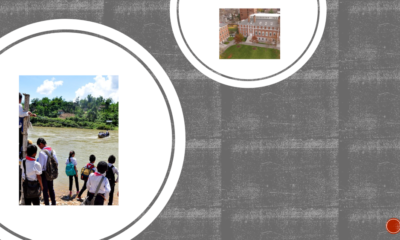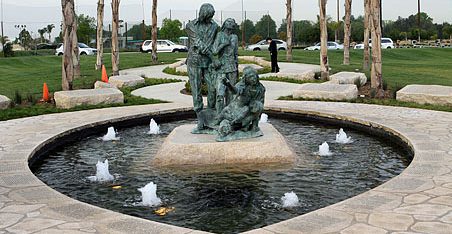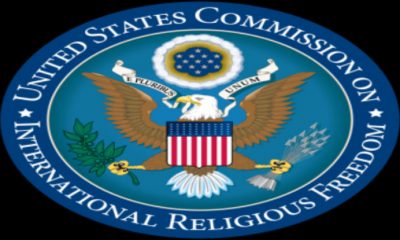(Vietnamese boat people Monument in California. Source: Duke University)
Professor Jana Lipman has just published the newest book about Vietnamese refugees from the early 1970s to the early 1990s to flee the Communist system. The purpose of this interview is to help readers to reach a deeper understanding of this research and a chapter of Vietnamese modern history that is still unknown to many Vietnamese people today. The Vietnamese version of this interview is available here.
(1) Dear Professor, in the international scholarship about postwar Vietnam, your book In Camps: Vietnamese Refugees, Asylum-Seekers, and Repatriates (University of California Press, 2020), is important because it provides a fresh account of that crucial historical period. You have also co-translated a moving memoir by the former South Vietnamese naval commander Trần Đình Trụ, Ship of Fate: Memoir of a Vietnamese Repatriate (Honolulu: University of Hawaii Press, 2017). Could you tell us why you are interested in studying this topic?
Well, this takes me back many years, but it begins with my decision to study abroad in Vietnam when I was an undergraduate. In 1994, I studied in Ho Chi Minh City/Saigon with the School of International Training. I was in one of the first groups of American students to study in Vietnam after the war, and it may sound cliché, but it was life-changing. I studied Vietnamese every morning and explored the city on bike in the afternoons. While I did not continue with language study, the questions that emerged from that experience about the legacies of war, U.S.-Vietnam relations, and migration have driven my research interests ever since.
And thank you for recognizing Trần Đình Trụ’s Ship of Fate: Memoir of a Vietnamese Repatriate. After I published my first book on the U.S. naval base in Guantánamo Bay, I began researching how U.S. military bases had been used as refugee camps for various populations (Hungarians, Vietnamese, Cubans, and Haitians).
In the course of this research, I learned about how the US had transformed Guam into a refugee camp at the end of the US War in Vietnam. As most people know, in April 1975, approximately 120,000 Vietnamese fled South Vietnam, and the majority resettled in the United States. However, before they came to the continental United States, the military sent most to Guam for processing.
When I was reading the military’s After Action Reports, I came across remarkable photographs of Vietnamese on Guam who wanted to return to Vietnam and did not want to go to the United States. The images were striking and included protests, collective head shavings, and mass demonstrations. These individuals called themselves the repatriates, and they wanted to return to Vietnam.
I imagined I wouldn’t be able to find more information about the repatriates, but I was very wrong. Not only were there hundreds of U.S. documents on this topic, but I then found Trần Đình Trụ’s memoir in the Library of Congress in Washington, DC. I believe it is the only first-hand account by a Vietnamese man who was a Vietnamese repatriate on Guam. Trần Đình Trụ was a high ranking South Vietnamese naval captain, and he became the captain of the Việt Nam Thương Tín, which sailed more than 1500 people back to Vietnam in October, 1975. Tragically, the new Vietnamese government sentenced him to more than a decade of forced labor and detention in the country’s “re-education camps.”
My colleague Bac Hoai Tran and I agreed the story was powerful, and we wanted to bring it to a broader audience. We worked together with Trần Đình Trụ to translate his memoir into English, and I’m extremely proud that his story and experience is now accessible to an English-speaking audience.
(2) Most Vietnamese who were born in North Vietnam after 1975 like me do not understand the nature of the problem of Vietnamese refugees during 1975-1989. Could you give us a brief overview of this historical tragedy: what happened and why so many wanted to leave Vietnam?
There are so many stories, and one of my goals is to recognize that Vietnamese who left the country did so for a range of reasons. That said, I would agree with the general scholarly consensus that there were three main time periods or “waves.”
First, in 1975, approximately 120,000 Vietnamese left in April, 1975. Most of these men and women had connections to the U.S. government and identified with South Vietnam. They feared repercussions if they remained in the country, and this led to the 1975 evacuation. Although I have studied the repatriates who returned to Vietnam later that year, the vast majority resettled in the United States, Canada, and Australia.
Second, in the late 1970s, there was another “wave” of Vietnamese migrants. After 1975, the new revolutionary government sent ARVN military personnel to the euphemistically labeled “re-education” camps. These were prison camps and were characterized by poor diets, political indoctrination, and forced labor. Many of these men were released after two to three years, and so in the late 1970s, there was a new group of Vietnamese who wished to leave the country. In addition, the government accelerated its plans against private property in these years and sent families to New Economic Zones. By this point, numerous southern Vietnamese who had been waiting to see what the new government would bring became disillusioned and again wanted to leave. Finally, during these years, many Chinese Vietnamese were incentivized to leave. Disproportionately represented in the commercial sectors, the Vietnamese government attacked their livelihoods. Next, the Vietnamese government facilitated their emigration by taking bribes and organizing large ships to leave the country. While these individuals left by sea, many left in large commercial ships like the Skyluck and the Hai Hong, rather than the rickety boats most Americans picture in their minds. This anti-Chinese policy also was part of Vietnam’s brief war with China in 1979. These collective changes led to the first “boat people” crisis in Southeast Asia, leading to tens of thousands of people fleeing to Thailand, Malaysia, Indonesia, and Hong Kong.
Finally, in the 1980s, thousands continued to leave Vietnam, but by this point, for an even larger range of reasons. People who faced discrimination and persecution due to their former involvement with South Vietnam continued to leave the country, and this included large numbers of re-education camp survivors. Others left northern Vietnam, because they had come into conflict with local leaders. Some were former communist party members who had initially supported the revolution, and still others had always opposed the government. However, U.S. officials often could not “see” these individuals as “refugees,” because they had not been aligned with South Vietnam. Finally, a large number of people left for a combination of political and economic reasons. The UNHCR and the US often try to distinguish between political persecution and economic reasons, but in practice, these two are often combined.
The US and Vietnam also established the Orderly Departure Program. This was to enable Vietnamese to leave the country and resettle in the United States without risking their lives via a dangerous sea journey. This program stalled in the early 1980s, but accelerated in the late 1980s and early 1990s. It became closely associated with resettling Vietnamese Amerasians and their families.
In other words, there was no single story.
(3) Many Vietnamese today support the struggle for democracy and freedom of Hong Kong people because Hong Kong previously helped Vietnamese refugees. You wrote in an article that the activities of human rights defenders in Hong Kong who helped Vietnamese refugees “[demonstrate] how fighting for the rights of a vulnerable minority in any country creates protections and civil liberties enjoyed by all”. Could you please tell us the history of Vietnamese refugees in Hong Kong, and please explain the relationship between human rights protection activities for Vietnamese refugees in Hong Kong 30 years ago and the protection of freedom and democracy in Hong Kong today.
I should start by saying that the history of Vietnamese refugees in Hong Kong is quite complicated, and it spanned more than two decades.
From 1975 through the early 1980s, Hong Kong offered some of the most generous benefits and support for Vietnamese refugees who entered the territory. Unlike in Thailand, Malaysia, or Indonesia, the Hong Kong government never “pushed off” boats or sent them away, and instead, offered all first asylum.
However, the Hong Kong government soon found that it was overwhelmed with Vietnamese, and Vietnamese were lingering in the camps for years. This led the Hong Kong government to initiate a “closed camp” policy to deter new arrivals. Hong Kong also received more people from northern Vietnam, many who may have faced persecution, but whose stories did not match what the United States (or the UNHCR or Hong Kong officials) had come to see as a legitimate refugee story, e.g. a family member had served in the RVN military and had a close relationship to the US military. As a result, Hong Kong faced a “long stayer problem,” with thousands of Vietnamese in limbo in the camps.
Hong Kong was also a British colony. The British and Chinese had agreed that Hong Kong would be returned to China in 1997. This raised numerous questions about Hong Kong’s rights to political autonomy and the rule of law (conflicts that remain acute today). Hong Kong officials (British and Chinese) felt an obligation to uphold humanitarian standards. At the same time, they wanted to close the camps before the July 1, 1997 handover. The result was Hong Kong’s controversial decision in 1988 to begin “screening” Vietnamese who arrived in the territory. Those who were able to “prove” they were refugees would be resettled in the US, Canada, Australia, or Western Europe. Those who could not “prove” they were refugees were sent to closed camps, more akin to prisons, and then faced repatriation back to Vietnam.
In the 1990s, Vietnamese in the camps and Vietnamese in the diaspora protested Hong Kong’s new policies. On the one hand, Hong Kong government officials argued that they offered humanitarian asylum. They had met their obligations with the UNHCR, and they faced immense local pressure. They argued they had done enough. On the other hand, Hong Kong became an extremely punitive place, and Vietnamese in the camps staged massive protests, hunger strikes, and demonstrations against the screening process and forced repatriations. Vietnamese Americans often argued that Hong Kong violated Vietnamese human rights. In addition, many Hong Kong activists took up their cause and fought to improve the screening process and against forced repatriations back to Vietnam. They recognized that protecting Vietnamese rights to due process and the rule of law would matter for Hong Kong after the reversion to Chinese sovereignty.
In my book, In Camps, I analyze how Hong Kong became ground zero for debates over humanitarianism and human rights in the 1990s.
(4) Your book also argues that the tragedy of Vietnamese boat people reshaped the UN and the United States’ international refugee policy. Could you please elaborate on this?
Yes. The exodus of Vietnamese received more attention in the UNHCR and the United States than any other refugee population at the time. This was obviously due to the US involvement in the war in Vietnam.
For the UNHCR, this was its first major refugee operation in Asia, and it took significant financial and personnel resources for over two decades. The UNHCR also worked to develop regional solutions with Vietnam, first asylum sites, and resettlement countries. There were two major regional agreements. In 1979, there was an agreement, which provided all Vietnamese with de facto refugee status, the right to the first asylum, and the right to resettlement in a third country. Then in 1989, the UNHCR supported the Comprehensive Plan of Action, which moved to individual asylum hearings. This was the formula whereby Vietnamese who arrived after 1989 would no longer be de facto refugees, and would instead have to “prove” their cases through individual hearings.
The Comprehensive Plan of Action was incredibly controversial, and most Vietnamese diasporic organizations opposed it, because it included repatriations back to Vietnam. That said, the UNHCR insisted that it was working with regional partners, providing funds for repatriates to return and start new livelihoods, and end the “boat people” crisis. For the UNHCR, it believed there needed to be limits, not everyone who escaped their country by sea was a refugee according to the 1951 Geneva convention. The UNHCR feared if it insisted all Vietnamese were refugees indefinitely, then Southeast Asian countries would stop providing first asylum. The UNHCR saw the Comprehensive Plan of Action as a valuable regional solution, with large financial support from the United States, Japan, and the European Union. For all its flaws, and there were many, it was a regional agreement. For colleagues like myself who are concerned with refugees today, it is hard to imagine a similar regional agreement in the Middle East or Central America.
For the United States, the Vietnamese exodus in the 1970s also fundamentally reshaped US refugee policy. The huge numbers that fled in 1978 and 1979 overwhelmed first asylum countries like Malaysia and Thailand, and the U.S. initially admitted Vietnamese on an ad hoc basis. There was no refugee law, and it was a matter of presidential or executive authority.
This led Congress to pass the 1980 Refugee Act, which still governs US refugee policy. The Refugee Act allowed the United States to position itself as a generous nation that welcomed refugees. However, US refugee policy has always been political, and with the U.S. renewal of diplomatic relations with Vietnam in the mid-1990s, the U.S. would begin treating Vietnamese migration as it did for other nationalities.
In fact, the individual asylum hearings and detention policies that I spoke about above in Hong Kong, were quite similar to the detention and asylum policies that the United States was instituting for Haitians in Florida (Krome detention center) and the US naval base in Guantánamo Bay.
Today, under President Trump, the US has the lowest rates of refugee resettlement since the law’s passage in 1980. Instead, US policies look much more like Hong Kong in 1989-1997, with an emphasis on detention and deportation.
(5) Despite the passing of several decades, the Vietnamese diaspora maintains a close relationship with their relatives in Vietnam and many visit their former country regularly. Yet there is still so much raw anger within large segments of the diaspora and deep distrust between them and the Vietnamese government. How would you explain this, and do you have any advice for the diaspora or the Vietnamese government to improve the relationship?
This is a great question, however, it falls a bit outside my expertise.
Instead, my book does look at how Vietnamese Americans helped advocate and support Vietnamese in the camps. A lot of scholarly literature represents refugees as being politically passive, and I want my book to dispel this idea.
For example, in 1979, Vietnamese in the United States lobbied the UNHCR and supported the 1979 agreement that offered all Vietnamese refugee status, and they began to create networks to advocate for refugee resettlement. In the 1980s and 1990s, Vietnamese Americans became more politically active, some organizations lobbed Washington, DC for more US support, others sent lawyers and advocates to Hong Kong, and still others worked to educate people in the United States about the camp conditions.
My work shows how Vietnamese in the diaspora identified with the Vietnamese in the camps – it was often only luck and/or timing that separated those in the US or Australia from people waiting in Malaysia or the Philippines.
For good reasons, journalists and writers documenting the refugee crisis generally concentrated on desperate people in small boats at sea; however, I also wanted to draw attention to Vietnamese diasporic activism and their political strategies. As a result, In Camps argues how Vietnamese Americans (and others in the diaspora) were active in supporting refugee resettlement and how they developed diverse strategies to bring the stories of Vietnamese in camps to light.

 Politics & Economy4 years ago
Politics & Economy4 years ago
 Society & Culture5 years ago
Society & Culture5 years ago
 ARCHIVES5 years ago
ARCHIVES5 years ago
 Politics & Economy4 years ago
Politics & Economy4 years ago
 Politics & Economy1 year ago
Politics & Economy1 year ago
 Politics & Economy5 years ago
Politics & Economy5 years ago
 After 19751 year ago
After 19751 year ago
 Politics & Economy4 years ago
Politics & Economy4 years ago








